World's first graphene-enhanced

concrete slab poured in England
Idealized Supply Chain Design: Towards Ideality
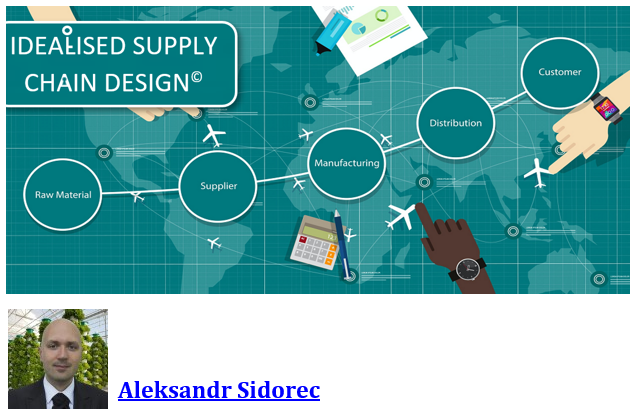
Igniting Food Systems Revolution | Industry 4.0 Partner @ Cognizant
Five years ago, I came across an OODA loop model (observe-orient-decide-act) developed in the 1960ies by military strategist Air Force Colonel John Boyd to support fighter pilots and their decision-making tasks on the battlefield. Indeed, you might draw parallels with some modern frameworks, but this is not an objective here. What impressed me is his serious approach to assessing implications triggered by the second law of thermodynamics and its further impact on military strategy.
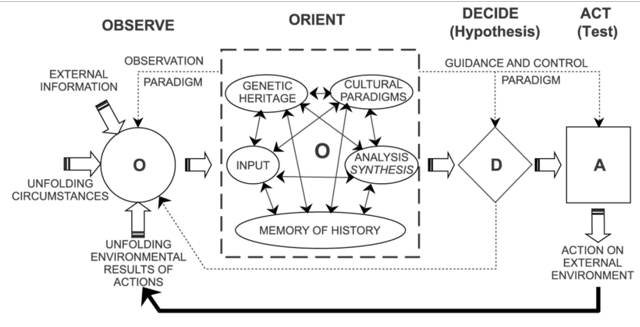
Boyd’s definition of the law was much more “user friendly” than the versions we usually find in the works of Kelvin, Plank, and others. He stated that:
“… entropy of any closed system always tends to increase and thus the nature of any given system continuously changes even as efforts are directed toward maintaining it in its original form.”
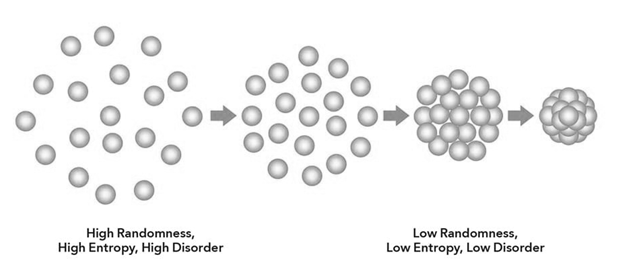
That was an exciting insight that stimulated my further thinking in the supply chain domain. Despite all efforts that we put in to control the flows, the environment continuously brings us even more challenging conditions. We try to impose even more control and organization over it. But how successfully?
I have not continued massaging this mental model too long, as my attention slipped to another point that this law highlights. Any organized system will continuously tend towards the increasing levels of entropy, at the same time, it always aims at minimizing its energy state. Well, the more we want to organize and control the system, the more energy we will spend on it, yes?
While incubating those cosmic thoughts, I felt like Don Quixote fighting with windmills in real life. The nature of supply chain challenges I had to orchestrate with my global team felt like solving fundamental contradictions rather than trade-offs that we historically managed across many industries. I had to build operating models that were both agile and lean, deliver superior service to the markets while meeting aggressive cost-cutting goals, activating efficiencies, and increasing the level of customized solutions. Contradictions.

How can we orchestrate supply chain contradictions? During my next jump into a mental rabbit hole, this is the question I was researching. One online statement captured my attention: “…every technical system aims to reach its maximum state of ideality — function is performed (or need is fulfilled), but there is no system”.
That made sense considering conclusions from the second law of thermodynamics and minimization of energy consumption made me pause. From that moment, my introduction with Genrich Altshuller started (founder of TRIZ) that later led to the definition of Idealized Supply Chain Design principles inspired by pieces of training and work of TRIZ Master Valery Souchkov.
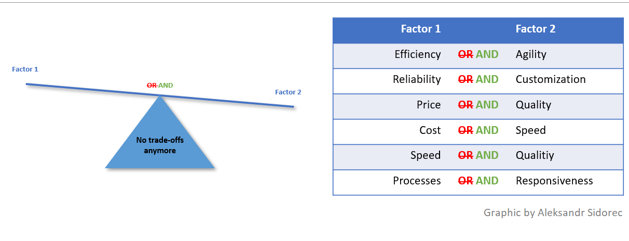
Let me first give you an initial overview of TRIZ itself.
TRIZ (translates from Russian as Theory of Inventive Problem Solving) had its starting point back in 1946 when Soviet inventor Genrich Altshuller and his colleagues ran research with thousands of patents. They discovered and coded specific patterns of technical systems’ evolution.
The main message is that evolution of a technical system is not a random process but is driven by specific regularities and has consistent patterns. These patterns can be used to consciously develop a system along its path of technical evolution and get to the breakthrough innovation by solving very complex problems in engineering. By that time, Altshuller and his students came with a definition of “contradictions” and developed frameworks that are helping to solve issues on the lowest levels of any technical system. Today technical TRIZ is actively applied in such companies as Samsung, Philips, LG Electronics, and many other names from the Fortune 500 list.
Since the 2000s, TRIZ had another evolutionary boost by actively expanding its application in other non-technical domains thanks to the passion and the drive of a tiny and dedicated group of professionals: in education, business, and software engineering. My kids are an excellent example as they participate in several training platforms that utilize TRIZ educational methods to bolster children’s creativity and systematic problem solving.
Let’s get to the basics now…
One of the core principles we will work with is the system’s ideality. As supply chains are engineered systems, those are architected to perform several functions. Based on the principle of ideality:
a perfect supply chain performs all the functions it was designed for without using any resources or creating any harm to itself, people, its product, the environment, or society.
In other terms: the consumer receives the product, but there is no supply chain behind it.
Any change in the supply chain that improves the performance of its designed functions or reduces the number of resources or the degree of harmful effects and waste will advance it towards ideality. Such a mental model is critical when we zoom out to the level of strategic planning and business / operating model architecture.
It is essential to note the focus is on the function and not the supply chain itself.
The operating model of the supply chain can be changed from the ground up as long as the new model meets its intended goals.
For instance, if we want to deliver a specific product to a consumer, we have several models at our disposal, each of which applies different operating principles:
‣ Product is packed and delivered by the courier to the consumer’s door
‣ Pack is picked by an autonomous vehicle and delivered to the destination
‣ Consumer downloads CAD technical drawing and prints the product at home
The delivery of the goods will be considered ideal when: the product appears in the right place, at the right time, and in the correct quantity without requiring any logistical system to get it to the consumer. Science Fiction? Not necessarily.
The objective of such a model is not to create a Space conquest strategy for the Supply Chain Management domain (although you might certainly discuss this idea with Elon Musk as he will need Space Logistics experts soon). Rather than move us outside of psychological inertia when we are trying to solve problems across the value chain in the same way others do. This barrier to innovation becomes even more critical when we intend to redesign the whole operating model of the enterprise to activate new levels of competitive advantage.
What often happens? We have a hammer, and we see the nails everywhere. As a result, we tend to solve problems or implement solutions based on predefined templates of models and behaviors instead of creating tailored and unique system structures relevant only to you, your company, and the particular context of the business.
Why is this important within the strategic layer of the supply chain model? Because technology becomes quickly obsolete and is becoming quickly commoditized, causing the problem that it is hard to build a competitive strategy just on this. Exciting potential lies in an intelligent blending of different elements to activate new capabilities and functions.
The best way to represent such a level of ideality through the simple formula that I have adopted from the works of Valery Souchkov:
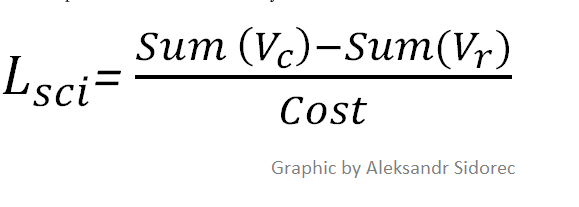
Li = Level of Supply Chain ideality
Vc = Value-creating factors (e.g., speed, flexibility, consumer satisfaction, etc.)
Vd = Value reducing factors (e.g., waste, environmental impact, long lead times, etc.)
Cost = all the costs associated with running and executing such a supply chain
The formula clearly states where our focus should be.
When discussing the topic of ideality, it is worth considering some of the trends related to the evolution of the technical system.
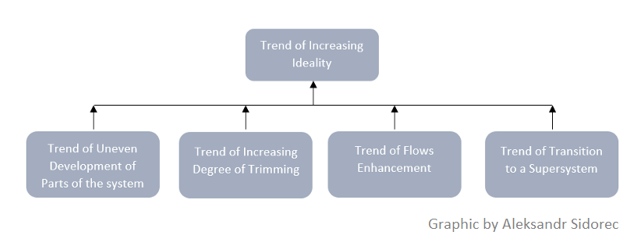
I have listed just a few examples that boost the state of the supply chain’s ideality. Still, we will have a deeper look into that in later publications considering that this forms an essential foundation when an organization sets an ambition to make a quantum leap in its business performance.
Before we deep dive into the some of those trends in the context of our daily operational realities, I should clarify some relevant definitions related to:
‣ Trimming
‣ Supersystem
Trimming in the supply chain. When applying the trimming process, we look for ways to reduce (to trim) some of the components involved in a specific supply chain activity. Their functions are redistributed amongst other (existing or improved) components. This process might lead to better operational costs, safety, and processing speed.
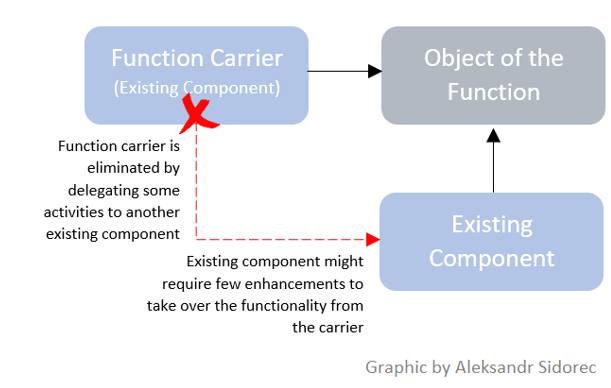
Let’s assume that based on functional analysis (analogue of process analysis/value stream mapping), we have identified a set of activities that are performed within a specific part of the supply chain. For example, and to provoke some out-of-box thinking, let’s look at the case of international container shipments causing many challenges today due to global imbalance on the freight markets.
The Core Elements of the ocean freight flow are the following:
Vessel — Container — Product
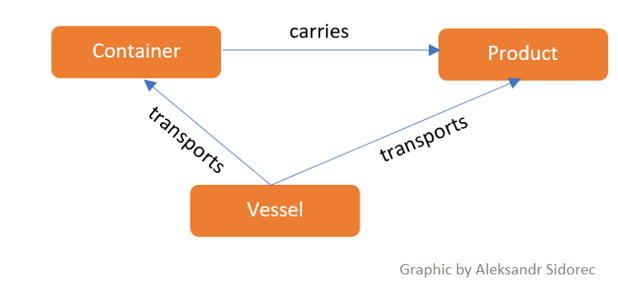
We know that a vessel’s availability is one of the factors currently causing adverse effects within our supply chain system. So, let’s take it out of the equation and delegate the transportation function to the container. So, the new system would be something like this:

Imagine the ocean full of self-sailing and navigating containers using electro-drive powered by solar energy.
Trimming is a powerful standalone tool that can help reduce costs across the value chain and should be used as collaborative work between procurement and technical functions. I will publish different material on this subject.
Supersystem of the supply chain. The supersystem is one of the core elements of the Idealised Supply Chain Design framework. The main point here is that the supply chain is not an isolated activity but a part of the specific supersystem that the company operates in.
Here I am going to extend the work of Valery Souchkov. He made a deep analysis of the supersystem within TRIZ by defining the key elements of the supersystem’s completeness:
‣ Supersystem as a source of resources for a supply chain system
‣ Supersystem as a driver of lifecycle within a supply chain system
‣ Supersystem as a means of control within a supply chain system
‣ Supersystem as a source of a target for a supply chain systems existence
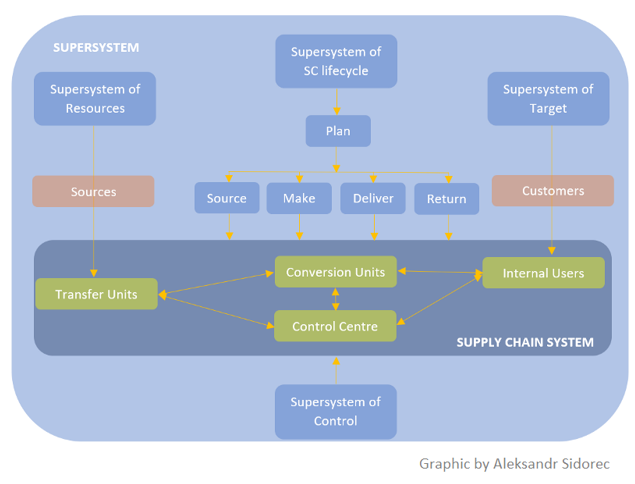
We can certainly draw a parallel between the supersystem and business ecosystem, which would be correct to a certain extent, considering there are elements mutually shared between both structures. In this context, a more correct view would be that the business ecosystem represents a sum of several supersystems that share common targets and objectives.
Now, here are some key elements related to our Supersystem:
🅐 Supersystem provides Resources necessary for Supply Chain System to execute its function and target. For example, it is possible to execute its function thanks to accessing the Sources = Vendors who are forming a critical part of the supersystem
🅑 Supersystem provides the Lifecycle of Supply Chain System, meaning that it provides everything necessary to ensure that various execution stages can be performed within the system. A minimum number of subsystems are available within a Supersystem to ensure that planning, sourcing, production, delivery, and returns can be executed. For example, in the case of Deliver stage, Supersystem provides an infrastructure (e.g., roads) that enables the execution of logistical function within the supply chain
🅒 Supersystem provides Control over the Supply Chain System that is activated thanks to the minimal number of subsystems within the Supersystem itself. For example, the driver operates the forklift in the warehouse, but the Warehouse Management System is used to guide the picking locations
🅓 Supersystem as a source of Supply Chain Systems Target provides a minimal number of subsystems necessary to ensure that the system effectively executes its primary purpose and function. For example, Supersystem provides the customers or consumers who have specific expectations related to the final product of such a system. Otherwise, the system would be supplying the goods to the markets that do not exist (previously I would joke regarding the supply of refrigerators to the North Pole, but with all the environmental challenges and temperature changes past 5 years, this might become a new reality)
Now we come to the Supply Chain System itself. It has a minimal viable structure (MVS) that usually includes Transfer Units, Conversion Units, Control Centre, and Internal Users. But in order not to overload this publication, I will skip details at this stage.
Let’s return to our conversation about the technical systems trends and their applicability within the supply chain domain.
Most interesting is that by combining the knowledge about such trends with S-curve analysis, we are well-positioned to forecast several scenarios about supply chain systems’ further development in the context of specific business activity. This knowledge gives us the means to design a long-term transformation roadmap for a specific operating model and its subsystems. But this should be performed in combination with trends of consumer behaviors evolution that we will analyze in another upcoming publication.
Why is this important? Idealized Supply Chain Design operates across several layers, each with its own set of tools and toolkits that could be applied to solve strategic, resource-based, and operational challenges within the supply chain.
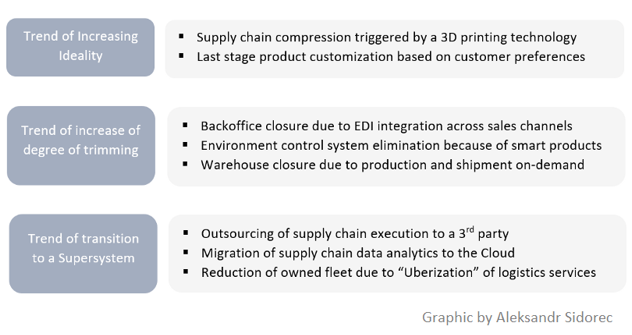
This information means that we will need to work from a strategic level. We are having a systematic look at the supply chain as a whole, including analyzing its subsystems and the current state of the supersystem. We do not want supply chain engineers and architects to implement the changes across the business value chain so that no supersystem can support this.
We do not need to go far away, for examples. We already have hydrogen-powered engines and cars available, but there is a lack of access to the fuel itself. Another example is when you develop automated warehouses for inbound cargo handling. Still, your supply base is not ready to adopt because of new palletization requirements so that you can have smooth warehousing operations and a low level of exceptions handling.
We move into resource management from the strategic level blended with processes and flows. Those are the layers where we usually start facing first contradictions that will not accept simple trade-offs but require a disciplined and structured work of resolving them. And that is where the miracle of idealized supply chain design begins.
This publication contains an introductory overview to give the reader a high-level understanding of some essential principles related to the Idealised Supply Chain Design. The following article will provide insights about the “soft” elements of the discipline — psychological inertia and role of abstractions, why those are important and relevant for supply chain practitioners.
Stay tuned. More to be published on the topic…
About the Author: Aleksandr is Advisory Partner Industry 4.0 @ Cognizant. He is on a mission of supporting clients across AgriFood, FMCG, and Retail sectors to accelerate value chain transformation boosted by the Internet of Things (IoT) and intelligent data leverage. Previously he spent 18 years shaping operational capabilities for the Fortune 500 companies: Olam International, Holcim, Johnson & Johnson, Caterpillar / Zeppelin, and Procter & Gamble.
He blends his professional activity with a personal exploration of startup ecosystems combined with research related to Lean Six Sigma, Inventive Problem Solving (TRIZ), and Systems Engineering to activate solutions for the most challenging issues across the supply chain domain.
More information: www.sidorec.com
Idealized Supply Chain Design (ISCD) by Aleksandr Sidorec is licensed under a Creative Commons Attribution-NonCommercial-NoDerivatives 4.0 International License
OUR CONSCIOUS AND SUBCONSCIOUS MINDS: A POWERFUL DUO By Stuart G. Walesh
This article explores the idea that professionals will be even more innovative if they proactively use their complementary conscious and subconscious minds. It begins by describing our two minds with emphasis on how they work. The article introduces the double-diamond process as a way of thoroughly defining and then solving a problem. It discusses tools available for taking a whole-brain approach -- left and right hemisphere and conscious and subconscious mind -- to innovative problem solving. The article concludes by offering ideas on why some tools work well, especially in more fully engaging our complementary conscious and subconscious minds.
This article presents the basics of our brain’s conscious and subconscious thinking processes and asserts that knowledge enables us to be even more innovative. We often hear about our brain’s very different left and right halves or hemispheres and benefit from that information. In contrast, we seem to be less conscious of our conscious and subconscious thinking. Let’s rectify that imbalance so that we are prepared to engage in what I call whole-brain thinking (Walesh 2017) -- intentional and effective use of our left and right hemispheres and conscious and subconscious minds.
I use the word subconscious to refer to brain processes that lie below what professor Rollo May (1976) calls our “level of awareness.” Other terms for the subconscious are unconscious and preconscious.
We are very aware of the capabilities of our conscious mind. It explicitly drives our work and other lives. My hope is that you will, because of reading this article about conscious and subconscious thinking, more proactively engage your subconscious mind.
As explained by neuropsychologist Paul D. Nussbaum (2010), we can think of the brain divided into ‘top-down’ orientation, with the cortex at the top and the subcortex at the bottom as suggested here:
Nussbaum says that the cortex “is a convoluted mass of cells, with folds and flaps that sits snug within your skull.” He explains that “the cortex is primarily responsible for the most complex thinking abilities, including memory, language, planning, concept formation, problem solving, spatial representation, auditory and visual processing, mood, and personality.” Cortex processing is conscious; it is intentional.
Positioned beneath the cortex, the more primitive subcortex “primarily processes rote skills and procedures” with most of the processing being subconscious (Nussbaum 2010). Examples of subconscious activities are word processing, tying your shoes, and driving -- things we do habitually. The cortex and subcortex connect in many ways and work very effectively together.
Scientists share widespread agreement about the existence of conscious and subconscious cognitive processes but the precise location of the processes is somewhat uncertain. For example, while Clayman (1991) and Mlodinow (2013) generally support Nussbaum’s cortex - subcortex model, biologist and researcher John Medina (2008) says, “We don’t know the neural location of consciousness, loosely defined as that part of the mind where awareness resides.” Nussbaum (2014) says there is “no real conflict” because “the brain does work in harmony, yet it can also maintain regional specialization.”
Psychiatrist Scott Peck (1997) says, “The conscious mind [drawing on information from our senses and memory] makes decisions and translates them into actions.” As an example of using your conscious mind, you define a problem, develop alternative solutions, compare them, select one, and recommend it. You are aware of the cognitive processing required for that process. With our conscious mind, we are thinking and we know it.
In contrast, the cognitive processing in the subconscious mind occurs without our being aware of it. “The [subconscious] mind resides below the surface;” according to Peck, “it is the possessor of extraordinary knowledge that we aren’t naturally aware of.” In the case of our subconscious mind, we are thinking and we don’t know it. During that conscious problem-solving process described in the previous paragraph, we can be certain that the subconscious mind is influencing, unbeknownst to us, the process.
One indication of the functioning of your subconscious mind: That great idea that “pops into your head” or “comes out of the blue.” The subconscious mind, if we can more effectively use it, has great potential as suggested by writer and anthropologist Martha Lagace (2012) who said “Our conscious mind is pretty good at following rules, but our unconscious mind -- our ability to think without attention -- can handle a larger amount of information. Studying the unconscious mind offers exciting new avenues for research, including creativity, decision making, and sleep.”
Considering further the relative impact on us of our conscious and subconscious minds, neuroscientist David Eagleman (2012) writes “consciousness is the smallest player in the operations of our brain. Our brains run mostly on autopilot.” The biggest player is our subconscious mind, which, as stated by Peck (1997), “resides below the surface.” As illustrated metaphorically in the following figure, conscious cognitive processing is the tip of the iceberg; subconscious cognitive processing is much larger and invisible.
Consider some more metaphors to help understand our conscious and subconscious minds and how they work together in a complementary manner. They also suggest how you can cause them to work even better together (all from scientist and theologian Murphy (2000), except as noted):
The following table further explains major differences between our conscious and subconscious cognitive processing. By leveraging those great differences, that is, by being aware of and linking them, we can enhance, individually and collectively, our innovation.
|
Conscious |
Subconscious |
|
When thinking, we know it |
When thinking, we don’t know it |
|
Intermittent |
24/7 |
|
Linear processor |
Parallel processor |
|
Slow |
Fast |
|
Prefers complete information in order to decide/do |
Can work with pieces |
|
Sees, or thinks it sees, what can be accomplished |
Believes that what is imagined by the conscious mind can be achieved and goes to work on it |
|
Does not control dreams |
Controls dreams |
|
Can change habits |
Source of habits |
Genrich Altshuller recognized the existence and complementary roles of our conscious and subconscious minds. He noticed that “many inventions were made in three steps. First, an inventor intensely and unsuccessfully searches for a solution. Then, having not solved the problem, he stops thinking about it. Some time passes, and suddenly, as if a delayed action mechanism goes off -- ‘as by itself” -- the required solution appears” (Altshuller 1999).
Read more: OUR CONSCIOUS AND SUBCONSCIOUS MINDS: A POWERFUL DUO

December 21, 2021
One of the critical issues with the current trend of bigger and bigger screens found on modern smartphones is that they get more easily damaged due to their size. On top of that, these larger, more complex screens are usually more expensive to replace or repair.
Scientists from Korea might have found a solution for this particular problem as they developed a self-healing material that can self-repair cracks and even restore damaged functions. Image Credit: encierro via Shutterstock / HDR tune by Universal-Sci
Image Credit: encierro via Shutterstock / HDR tune by Universal-Sci
The Korean researchers focused their attention on a material called CPI (colorless polyimide). The use of this material is widespread. It possesses excellent durable properties alongside good tensile strength, making it ideal for application in industries such as the aviation industry. Still, the material is also used in solar cells and flexible screens for foldable devices.
Several efforts have been made to improve the durability of CPI as the potential return on investment is enormous due to the material's large-scale use. Unfortunately, these attempts have, as of yet, not been successful. This makes potential self-healing technology even more relevant.
One of the challenges the research team encountered was that any self-healing technology should not tamper with the beneficial properties of colorless polyimide, including its transparency. The scientists opted for a creative solution, using linseed oil obtained from the flax plant seeds, also known as linseed. Linseed fibers are commonly used to make linen, while the researchers are more interested in its seeds. Perhaps there is some potential for synergy there. Oil extracted from flax seeds is quickly hardened and ideal to use as a coating material.
Using the flax oil, the team constructed oil-loaded microcapsules, with which they built the topmost healing layer by mixing them with silicone. When damage occurs, these microcapsules are supposed to break, leaking the flax oil filling the cracks, which quickly hardens, effectively restoring the screen. A considerable benefit derived from the mixed oil's liquid properties is that it naturally finds its way to the damaged area, repairing any local blemishes. ile:///C:/Users/Owner/AppData/Local/Temp/msohtmlclip1/01/clip_image005.jpg" alt="The self healing layer is flexible, twistable, bendable and foldable - Image Credit: Korea Institute of Science and Technology( KIST)" width="624" height="380" />

The self-healing layer is flexible, twistable, bendable, and foldable - Image Credit: Korea Institute of Science and Technology( KIST)
Another advantage of this semi-liquid solution is that it is usable on hard materials such as smartphone screens. Current self-repairing technology can only be applied to soft materials. The idea here is that the soft material melts by applying heat, smoothing out scratches and other marks. The microcapsule material renders an additional liquid layer on top of hard materials; this layer only becomes liquid when damaged. It can do so at room temperature without any additional heat requirements. It quickly hardens after it is exposed, making the surface hard again. The healing process can be performed within only 20 minutes as the material interacts with UV light. Simple but ingenious.

Robotic Fish Tail and Elegant 
Math Could Inspire Underwater Drones
Engineers uncovered the secrets of highly efficient swimming at varying speeds.

Picture by iStock
Underwater vehicles are typically designed for one cruise speed, and they’re often inefficient at other speeds. The technology is rudimentary compared to the way fish swim well, fast or slow.
What if you want your underwater vehicle to travel fast through miles of ocean, then slow down to map a narrow coral reef, or speed to the site of an oil spill then throttle back to take careful measurements?
Dan Quinn, an assistant professor at the University of Virginia School of Engineering and Applied Science, and his colleague, recent UVA Ph.D. graduate and postdoctoral researcher Qiang Zhong, discovered a key strategy for enabling these kinds of multispeed missions. They have demonstrated a simple way to implement this strategy into robots, ultimately transforming underwater vehicle design. Their work was recently published in Science Robotics.
When designing swimming robots, a question that keeps coming up for researchers is how stiff the piece that propels the robots through the water should be made? It’s tricky because the same stiffness that works well in some situations can fail miserably in others.
Read more: Robotic Fish Tail and Elegant Math Could Inspire Underwater Drones
Solving complex problems with even more complex solutions is a guarantee for even more problems.
 by Arno Koch
by Arno Koch
JUN 22, 2021
Now that even my fridge has to be "smart" and a simple sensor is called "4.0," I wonder. Does everyone have the same idea about the definition of Industry 4.0, and how far are we now really in this process? And what is 4.0 really about? I like to distinguish fact from fiction, and here are my conclusions.
Henry Ford created flow production, which allowed large quantities of the same product to be produced at affordable costs. He described this in several (still very readable) books. On the other side of the world, after World War II, these books were closely studied by one of his competitors: Toyota.
Toyota, originally a machine builder of looms, implemented Ford's principles in detail. However, there were two differences:
1. Whereas in the U.S., everything was abundant, on the Japanese island, with hardly any natural resources, scarcity of everything has traditionally prevailed, giving rise to an incredible focus on eliminating waste.
2. The Japanese have learned that only by working in close harmony with their environment and cooperating with the people around them can they produce enough to survive together.
These two characteristics were precisely decisive in the Toyota Production System: By working together in the constant struggle against losses, the famous TPS was developed after World War II during a phase of deadly liquidity problems.
Read more: Why '4.0' Is Often 3.0, and Smart Is Not Always Intelligent
World's first graphene-enhanced

concrete slab poured in England
By Nick Lavars May 25, 2021
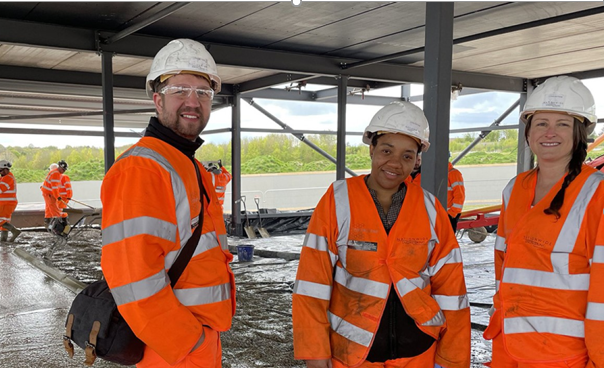
University of Manchester researchers Craig Dawson, Happiness Ijije and Lisa Scullion onsite as workers tend to the world's first graphene-enhanced concrete slab in the background.
University of Manchester/Nationwide Engineering
As the mostly widely used material on Earth, concrete has a massive carbon footprint that scientists are working to chip away at in all sorts of ways. Recent research projects have demonstrated how the wonder material graphene could play a role in this and now we are seeing the first real-world deployment of the technology, with engineers using so-called "Concretene" to form the foundations of a new gym in the UK.
As the world's strongest artificial material, graphene may have a lot to offer the world of construction, among its many other potential uses. Scientists have previously found success incorporating it into the concrete manufacturing process to make the finished product stronger and more water-resistant, while one research project even demonstrated how this graphene can be recovered from old tires.
Read more: World's first graphene-enhanced concrete slab poured in England (2)
World's first graphene-enhanced

concrete slab poured in England
By Nick Lavars May 25, 2021

University of Manchester researchers Craig Dawson, Happiness Ijije and Lisa Scullion onsite as workers tend to the world's first graphene-enhanced concrete slab in the background.
University of Manchester/Nationwide Engineering
As the mostly widely used material on Earth, concrete has a massive carbon footprint that scientists are working to chip away at in all sorts of ways. Recent research projects have demonstrated how the wonder material graphene could play a role in this and now we are seeing the first real-world deployment of the technology, with engineers using so-called "Concretene" to form the foundations of a new gym in the UK.
As the world's strongest artificial material, graphene may have a lot to offer the world of construction, among its many other potential uses. Scientists have previously found success incorporating it into the concrete manufacturing process to make the finished product stronger and more water-resistant, while one research project even demonstrated how this graphene can be recovered from old tires.
Read more: World's first graphene-enhanced concrete slab poured in England

First Human Uses High-Bandwidth Wireless Brain-Computer Interface
The device is called "BrainGate."
2 April 2021
Kevin Stacey

Brain-computer interfaces (BCIs) are an emerging assistive technology, enabling people with paralysis to type on computer screens or manipulate robotic prostheses just by thinking about moving their bodies. For years, investigational BCIs used in clinical trials have required cables to connect the brain's sensing array to computers that decode the signals and use them to drive external devices.
A BrainGate clinical trial participant uses wireless transmitters that replace the cables usually used to transmit signals from sensors inside the brain.Braingate.org
For the first time, BrainGate clinical trial participants with tetraplegia have demonstrated an intracortical wireless BCI with an external wireless transmitter. The system can transmit brain signals at single-neuron resolution and in full broadband fidelity without physically tethering the user to a decoding system. The traditional cables are replaced by a small transmitter about 2 inches in its largest dimension and weighing a little over 1.5 ounces. The unit sits on top of a user's head and connects to an electrode array within the brain's motor cortex using the same port used by wired systems.
Read more: First Human Uses High-Bandwidth Wireless Brain-Computer Interface


Four industry predictions from a manufacturing-tech strategist
John McEleney JAN 22, 2021
Like all industries, the design and manufacturing world experienced a shockwave of changes in 2020 due to the pandemic. As a result, many product development companies suddenly became more agile to pivot in new and innovative ways. Amidst the continued challenges of COVID-19 in 2021, this needs to be agile continues for businesses of all sizes.
Collaboration among remote workers will be just as important next year. As product developers create innovative solutions to rapidly changing problems, lead times from concept to manufacturing will need to keep shrinking to get products to market in time—before market conditions change yet again.
With all that in mind, here are my top four industry predictions for 2021:
Electric vehicles are garnering significant attention, but is the market ready to make the shift?

The age of electrification is here. Perhaps, more accurately, noticeable excitement and momentum are surrounding the ongoing development of electric vehicles (EVs). And, growing regulations around lower tailpipe emissions, increasing availability (and announced availability) of attractive options from both start-ups and automotive mainstays, as well as improving battery technology and better economics are collectively fueling the current surge.
"There is a fundamental belief that we are in a transitional period right now. The future will certainly include internal combustion engines (ICE) – although they won't have the same penetration as they enjoy today. And, we will most certainly have EVs," says Brian Irwin, managing director of Accenture's, automotive and mobility practice in North America.
Adding to the EV optimism, consumers who have already invested in electric vehicles are overwhelmingly impressed with the ICE alternatives. According to the results of JD Power's first US Electric Vehicle Experience Ownership Study, a whopping 95% of EV owners whose overall ownership satisfaction exceeds 900 points say they will purchase another EV with roughly two-thirds (64%) noting that they will repurchase the same brand. However, brand loyalty lessens as satisfaction declines. Specifically, owners whose satisfaction is between 600 and 750 points, 77% indicate they 'definitely will' purchase another EV—although their likelihood of repurchasing the same brand is only 25%."
Smart Concrete Paves Way to High-Tech Roads
Smart, efficient infrastructure just makes sense.
Nov 17th, 2020
Luna Lu & Vishal Saravade, Purdue University

Every day, Americans travel on roads, bridges and highways without considering the safety or reliability of these structures. Yet much of the transportation infrastructure in the U.S. is outdated, deteriorating and badly in need of repair.
Of the 614,387 bridges in the U.S., for example, 39% are older than their designed lifetimes, while nearly 10% are structurally deficient, meaning they could begin to break down faster or, worse, be vulnerable to catastrophic failure.
The cost to repair and improve nationwide transportation infrastructure ranges from nearly US$190 billion to almost $1 trillion. Repairing U.S. infrastructure costs individual households, on average, about $3,400 every year. Traffic congestion alone is estimated to cost the average driver $1,400 in fuel and time spent commuting, a nationwide tally of more than $160 billion per year.
I am a professor in the Lyles School of Civil Engineering and the director of the Center for Intelligent Infrastructures at Purdue University. My co-author, Vishal Saravade, is part of my team at the Sustainable Materials and Renewable Technology (SMART) Lab. The SMART Lab researches and develops new technologies to make American infrastructure “intelligent,” safer and more cost-effective. These new systems self-monitor the condition of roads and bridges quickly and accurately and can, sometimes, even repair themselves.
Imagine a flexible digital screen that heals itself when it cracks.
5 June, 2020 - National University of Singapore
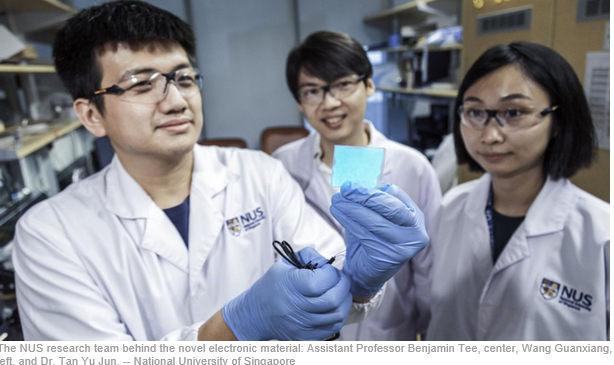
The NUS research team behind the novel electronic material: Assistant Professor Benjamin Tee, center, Wang Guanxiang, left, and Dr. Tan Yu Jun. -- National University of Singapore
Imagine a flexible digital screen that heals itself when it cracks or a light-emitting robot that locates survivors in dark, dangerous environments or carries out farming and space exploration tasks. A novel material developed by a team of researchers from the National University of Singapore (NUS) could turn these ideas into reality.
The new stretchable material, when used in light-emitting capacitor devices, enables highly visible illumination at much lower operating voltages and is also resilient to damage due to its self-healing properties.
This innovation, called the HELIOS (which stands for Healable, Low-field Illuminating Optoelectronic Stretchable) device, was achieved by Assistant Professor Benjamin Tee and his team from the NUS Institute for Health Innovation & Technology and the Department of Materials Science and Engineering at the NUS Faculty of Engineering. The results of the research were first reported online in the prestigious scientific journal Nature Materials on 16 December 2019 and were also published in print in the February 2020 issue.
Durable, low-power material for next-gen electronic wearables and soft robots
"Conventional stretchable optoelectronic materials require high voltage and high frequencies to achieve visible brightness, which limits portability and operating lifetimes. Such materials are also difficult to apply safely and quietly on human-machine interfaces," explained Assistant Professor Tee, who is also from the NUS Department of Electrical and Computer Engineering, N.1 Institute for Health and the Hybrid Integrated Flexible Electronic Systems program.
To overcome these challenges, the team of five NUS researchers began studying and experimenting with possible solutions in 2018, and eventually developed HELIOS after a year.
To lower the electronic operating conditions of stretchable optoelectronic materials, the team developed a material that has very high dielectric permittivity and self-healing properties. The material is a transparent, elastic rubber sheet made up of a unique blend of fluoroelastomer and surfactant. The high dielectric permittivity enables it to store more electronic charges at lower voltages, enabling a higher brightness when used in a light-emitting capacitor device.
Unlike existing stretchable light-emitting capacitors, HELIOS enabled devices can turn on at voltages that are four times lower, and achieve illumination that is more than 20 times brighter. It also achieved an illumination of 1460 cd/m2 at 2.5 V/μm, the brightest attained by stretchable light-emitting capacitors to date, and is now comparable to the brightness of mobile phone screens. Due to the low power consumption, HELIOS can achieve a longer operating lifetime, be utilized safely in human-machine interfaces, and be powered wirelessly to improve portability.
HELIOS is also resistant to tears and punctures. The reversible bonds between the molecules of the material can be broken and reformed, thereby allowing the material to self-heal under ambient environmental conditions.
Describing the potential impact of HELIOS, Asst Prof Tee said, "Light is an essential mode of communication between humans and machines. As humans become increasingly dependent on machines and robots, there is huge value in using HELIOS to create 'invincible' light-emitting devices or displays that are not only durable but also energy-efficient. This could generate long-term cost savings for manufacturers and consumers, reduce electronic waste and energy consumption, and in turn, enable advanced display technologies to become both wallet and environmentally friendly."
For example, HELIOS can be used to fabricate long-lasting wireless displays that are damage-proof. It can also function as an illuminating electronic skin for autonomous soft robots to be deployed for smart indoor farming, space missions, or disaster zones. Having a low-power, self-repairing, illuminating skin will provide safety lighting for the robot to maneuver in the dark while remaining operational for prolonged periods.
Next steps
The NUS team has filed for a patent for the new material and is looking to scale up the technology for specialty packaging, safety lights, wearable devices, automotive, and robotics applications.
TRIZ Principle #30 – Flexible Films, Thin Membranes, and Coatings
The nation can't rely on private R&D for a variety of reasons.
JAN 22, 2020
Just about everybody in the U.S. agrees that America must maintain its economic position and stay ahead of China and other foreign competitors, by using a strategy of innovation. Innovation is commonly defined as being first to acquire new knowledge through leading-edge research: being the first to apply that knowledge to create sought after products and services, and being the first to introduce these products and services into the marketplace. If the U.S. is committed to using innovation as its primary competitive strategy, then we must do a better job of doing the first step—leading-edge research.
Two fundamentally different kinds of research lead to innovation. The first is basic research, which is generally conducted by the federal government. The second is research and development—also called applied research—which is usually undertaken by private firms. Basic research differs from research and development because it investigates basic science and is high-risk and seldom results in commercial products in the short-term. Private research and development, on the other hand, uses the new technological ideas discovered by basic research to develop new products and is driven by shareholder value and short-term profits.
The United States has a long history of investing in federal basic research going back to World War II when federal research was used to develop radar, electronics, atomic power, jet fighters, and many other technologies used to win the war.
After the war, the US continued to invest in basic science research, which was used to create many of the technologies and industries we see today. Federal basic research was the initial research used in developing the Google search engine, global positioning satellites, supercomputers, artificial intelligence, speech recognition, the Internet, smartphone technologies, the shale gas revolution, seismic imaging, LED light technology, magnetic resonance imaging MRI, advanced prosthetics, and the human genome project. Many of these new technologies led to new industries spawning many new markets. An example that everybody understands is the internet developed by ARPANET (advanced research products agency) of the Defense Department.
The development of new technologies into useful products was accomplished by private companies, but all of these products came, initially, from federal basic research in many fields of science. As an example, transistors were not suddenly discovered by the electronics industry; they came from people working with wave mechanics and solid-state physics. Light-emitting diode technology began with the study of infrared emissions from gallium arsonide and other semiconductor alloys. Magnetic resonance imaging came from research into spin echoes and free induction decay.
How vital Is Basic Research?
A study published in 2019 in the journal Science shows that one-third of all U.S. patents since 1970 relied on government-funded research. The study was based on an investigation of all patents issued from 1926 to 2017 and underscores the importance of funding basic federal research.
The Decline of Basic Research
According to the Information Technology and Innovation Foundation, ITIF, federal basic research has been declining for 22 out of 28 years. The following chart shows that as a percentage of GDP, federal research had fallen from a high of 2.5% in 1964 to 0.61% in 2018.
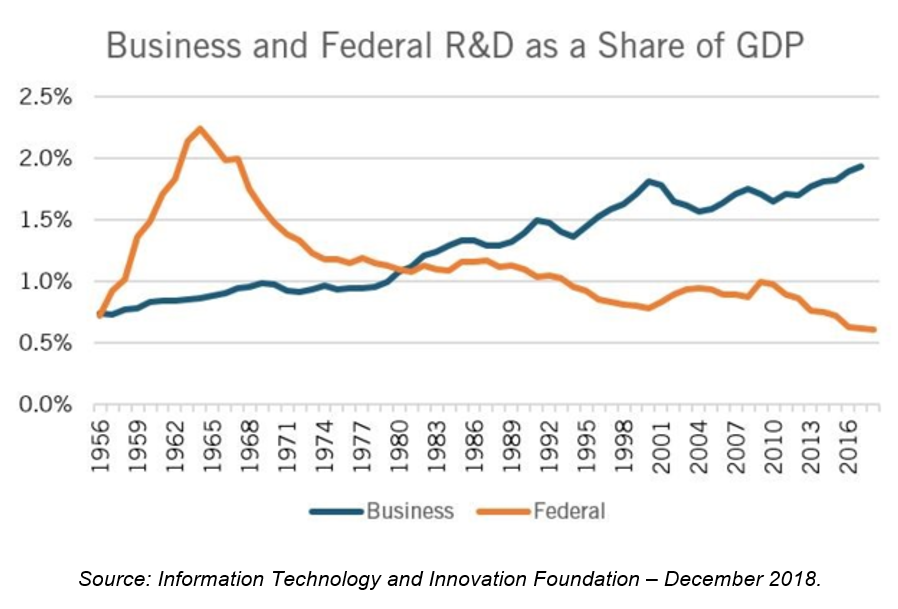
Source: Information Technology and Innovation Foundation – December 2018.
The chart also shows that business research and development as a share of GDP continues to grow. The chart begs an obvious question: Since private research and development has grown from 0.7% in 1956 to 2.0% of GDP in 2016, isn't this adequate to support our strategy of innovation? Do we need federal basic research? I will make the argument that the answer to both questions is no—that we need to increase the federal necessary research budget.
The primary reason we can't just rely on private R&D is that 80% of the funding of business research and development is applied research that leads to products, and the other 20% is basic research. This shift is because basic research is very risky; long-term; has uncertain applicability, and probably won't lead to short-term profits.
One of the big problems facing corporations is the dominance of the financial sector. In an earlier article, "We Must Save America’s Manufacturing Sector,” I showed that as the manufacturing sector has declined, it has been replaced by the service sector in terms of GDP and influence. Like it or not, America's multinational corporations are pushed to achieve short-term profits and shareholder value as their number one priority.
Since the financial sector is now the dominant sector in the economy, the trend to reduce costs, including R&D budgets, is gaining traction. According to the ITIF report on the ingredients of innovation, 80% of chief financial officers in the U.S. responded that they would cut R&D to meet their firms' next quarter projections. Also, manufacturing continues to move to foreign countries, taking research and development with them. According to the same ITIF report, "U.S.-based companies now have 23% of their research and development employment located abroad.”
Many of the boards of multinational corporations are being dominated by activist board members who want to achieve short-term profits any way they can. A good example is what happened to the DuPont Company. For more than 200 years, DuPont has invented innovative products sold all over the world. Their experimental station–a research lab–created products like Nylon, Freon, Lycra, Neoprene, and Kevlar. But in 2016, their fifth-largest shareholder, Trian Fund Management, demanded the company cut $4 billion from the business and double the stock price to optimize shareholder value.
In 2016, Trian Fund Management forced a change in the company's approach to research and development. They wanted to reduce R&D costs and do a stock buyback that would lead to quicker profits. They successfully did the stock buyback and laid off 5000 people worldwide. Part of this cost reduction led to a 20% reduction in the R&D budget, the layoffs of hundreds of research people, and the closure of one research lab.
A survey of the major corporations by Sullivan and Cromwell showed that in 2018, 260 activist campaigns were going on in the U.S. During this same year, according to a July 2019 report from J.P. Morgan, stock buybacks reached $800 billion. The point here is that the emphasis is on short-term profits, cost-cutting, and stock buybacks, which can cannibalize innovation, slow growth and harm U.S. competitiveness. In this environment, there is little chance that the investment in basic research by U.S. corporations will improve anytime soon.
Current problems
1. Foreign Competitors: The U.S. is not keeping up with foreign competitors in terms of investment in federal research. Federal research is now 0.6% of GDP and would have to be increased by $100 billion to equal 1980 levels. The article, “Dwindling Federal Support for R&D is a Recipe for Economic and Strategic Decline”, says that China's investment in government research has increased 56% since 2011 and Russia's expenditure increased by 13%. During the same period, the U.S. investment in basic government research fell by 12%. The article's summary states, “this is a recipe for decline, economically and strategically.” Using the measure of basic research as a fraction of GDP, the United States was ranked fifth among all nations.
2. Federal Deficits: One of the biggest problems facing the basic research budget, or any other non-defense budget, is the federal deficit. The national debt has grown to more than $22 trillion and is constantly used as the excuse to cut federal non-defense budgets. A good example is a need for an infrastructure program to improve our highways, bridges, ports, sewers, water lines etc. This problem has been ignored for 30 years and would now cost $4 trillion to fix. Because of rising deficits and debt, it is not likely Congress will invest in the infrastructure or federal basic research, even though both are critical to the innovation strategy that is supposed to fuel America's competitiveness. The federal necessary research budget is scheduled for a $5 billion cut in 2020.
Conclusions
The federal report “Rising Above The Gathering Storm Revisited” concluded that "the U.S. appears to be on a course that leads to declining, not growing, standard of living for our children and grandchildren.”
It is difficult to see the positive outcomes of an investment in basic research because it does not lead to visible products in the short term, and the long-term consequences from not investing in basic research are masked by short-term economic successes in the economy. In the long-term, disinvestment can lead to stagnant productivity, lagging competitiveness, and reduced innovation.
The problem of multi-national corporations bending to the will of the finance sector and focusing on short-term profits as their priority is beneficial to shareholders but may be devastating to the country over the long-term. Ralph Gomory, former senior vice president of science and technology at IBM, succinctly summarized our current situation. He said, "what is good for America's global corporations is no longer necessarily good for the American people."
America's stated goal is to compete in the world market by using a strategy of innovation. But if we can't invest in the necessary research and science that creates the opportunities for new technologies, it is difficult to see how America is going to compete with the Asian countries or remain the number one economy in the world.
Michael Collins is the author of The Rise of Inequality and the Decline of the Middle Class.
The 5 Biggest Challenges for Smart Factories (and Tips to Tackle Them)
An Intel survey of 400 manufacturing experts on the front lines looks at what it will take to clear Industry 4.0's highest hurdles.
Irene J. Petrick, Faith McCreary DEC 20, 2019 from IndustryWeek
With the increasing proliferation of data, connectivity, and processing power at the edge, the industrial Internet of Things (IIoT) is becoming more accessible. However, successful adoption remains out of reach for many: two of every three companies piloting digital manufacturing solutions fail to move into a large-scale rollout. Why is it that, despite enthusiasm for this transformation to a digital manufacturing future, few companies have realized its potential at scale?
We already know that AI and IoT at the edge are critical to the acceleration of factory transformation, but what is required to catalyze more rapid adoption of these technologies and avoid the pitfalls of pilot purgatory?
In the past two years, we have embarked on a study of over 400 participants across the industry and ecosystem companies, engaging manufacturing leaders and workers, as well as the technologists that develop the solutions and services that support them. To answer this very question and uncover the essential ingredients of industry 4.0. In 2018, we released Phase One of the study, identifying key issues that manufacturing leaders and factory workers are grappling with as they evolve together on the path to the intelligent factory future.
We’ve just released the next phase of this work, Accelerate Industrial, looking at how workers will adapt and react to AI in manufacturing roles, and what strategies and tactics will “accelerate the accelerators.” To date, this phased study represents the most comprehensive view of digital transformation happening in the manufacturing sector.
All Phase Two participants were required to have a first-hand role in a smart factory or a company that develops smart technologies, solutions, or services, encompassing the full spectrum of points of view across development, deployment, and maintenance of the technologies within those four walls.
Our research found that while there is a big appetite for digital transformation, 83% of companies say they plan to make investments in smart factory technologies in the next two to three years. The people who are the most likely to drive that change are frequently uncertain about how to move forward or hesitant to risk it. So, what accounts for this failure to launch or to scale? And how should leaders shift the cultural mindset within their organizations to reap the benefits of industrial IOT?
Here are the top five challenges, cited by respondents, that have the potential to derail investments in smart solutions in the future and tips for avoiding the perils of pilot purgatory:
Challenge #1: Technical Skills Gap
36% cite a “technical skill gap” that prevents them from benefiting from their investment.
To successfully implement new technology and maintain operations, a company must have a workforce that possesses “digital dexterity.” The people must understand both the manufacturing processes and the digital tools that support those processes.
Solution:
Challenge #2: Data Sensitivity
27% cite “data sensitivity” from increasing concerns over data and IP privacy, ownership, and management.
To successfully implement an AI algorithm, for example, requires that there is data to train it and test it. This means that data must be shared, yet many companies are unwilling to share their data with third-party solution developers. There is also a strong belief that our current data governance policies for internal use within the organization are inadequate to support cross-organizational data sharing.
Solution:
Challenge #3: Interoperability
23% say a lack of interoperability between protocols, components, products, and systems.
Interoperability is an ongoing struggle that is not new. Today, however, companies are becoming more frustrated with this interoperability as it limits their ability to innovate. It also limits their ability to upgrade system components, since they cannot easily “swap out” one vendor for another or one part of the system for another.
Solution:
Challenge #4: Security
22% cite security threats, both in terms of current and emerging vulnerabilities in the factory.
The combination of physical and digital systems in a smart factory makes real-time interoperability possible, but it comes with the risk of an expanded attack surface. With numerous machines and devices connected to single or multiple networks in the smart factory, vulnerabilities in any one of those pieces of equipment could open the system to attack. Companies will need to anticipate both enterprise system vulnerabilities and machine level operational vulnerabilities. Companies are underprepared to deal with these security threats, and many rely on their technology and solution providers to do this.
Solution
Challenge #5: Handling Data Growth
18% cite handling data growth in amount and velocity as well as sense-making.
As AI usage expands, companies will be faced with more data, being generated at a faster pace, and in multiple formats. AI algorithms need to be easier to comprehend i.e., how does the algorithm arrive at a recommendation? These algorithms must be able to combine data that is often of different types and timeframes.
Solution:
Irene Petrick is the senior director of the Industrial Innovation Internet of Things Group at Intel. Faith McCreary is a principal engineer in User Experience at Intel.
The 10 Top Skills That Will Land You High-Paying Jobs by 2020, According to the World Economic Forum
They surveyed 350 executives across 9 industries in 15 of the world's biggest economies --- the answers may surprise you.
By Melanie Curtin Writer, activist@melaniebcurtin
Professional development: it's not always clear what to focus on. Should you go to a coding bootcamp? Invest in a social media marketing course? Attend a communications training? What should you do to help you excel in your current job -- or prepare you for your next one?
According to the World Economic Forum (WEF), the answer is simple.
The WEF recently surveyed 350 executives across 9 industries in 15 of the world's biggest economies to generate The Future of Jobs. The report intended to predict how technological advancement will transform labor markets. In other words, how will technology impact employers, and therefore, what they'll want from employees?
In a world increasingly dominated by robots, artificial intelligence, and virtual reality, having a firm grasp of what employers will be looking for is smart. Interestingly, more than 33% of the skill sets listed are not yet considered important by employers. They may not be on their radar now--but they will be.
The top 10 skills that will be most desired by employers by 2020:
This involves creativity, logical reasoning, and problem sensitivity. It also means being able to adapt to how you communicate based on who you're talking to. Employers want to know you don't just say the same thing to everyone -- that you think critically about who you're talking to, deeply listen, and tailor communication to that person.
This will be in especially high demand in computer and math jobs, such as data analysis and software development. It will also be critical in the arts and design (including commercial and industrial designers).
This was defined as actively seeking ways to help others. How much do you assist those on your team, your superiors, and people across your industry? How much are you known for that?
As organizations collect more and more data, there will be an even greater need for workers who can analyze it and use it to make intelligent decisions. Good judgment also involves knowing how to get buy-in from a colleague, or making a strong suggestion to a manager (even if it might not make you popular).
Robots can do a lot, but they still can't read people the way other humans can (at least not yet). Employers will place a strong emphasis on hiring those who are aware of others' reactions, as well as their own impact on others.
Again, this falls under the social skills umbrella (sensing a trend?). It involves being able to collaborate, adjust in relation to others, and be sensitive to the needs of others.
In the report, this included being able to motivate people, develop the talents and skills of employees, and pick the best people for a job. This will be especially in demand for managers in the media and energy industries.
In 2015, creativity ranked 10th on the list. It's now one of the top three skills employers will seek. Why? Because as we're bombarded by new technologies, employers want creative people who can apply that tech to new products and services.
As automation increases, the need for humans who can employ logic and reasoning increases. This is, in part, because machines must be directed ethically and optimally. Employers want people with critical minds who can evaluate the uses or abuses of the power of technology, and use them to benefit the company, the people in it, and the future.
Technology can make life easier, but it can also make things more complicated. For example, you could use wearables to help map the walking patterns of nurses and doctors in a hospital to see how to make things more efficient. But without a human being analyzing those results while also having intelligent conversations with nurses, doctors, and patients, you will likely end up with a wrong or even dangerous result.
The report shows that 36% of all jobs across all industries will require complex problem-solving abilities as a core skill by 2020.
TRIZ Plus – A Modern Tool for Enhancing Design Innovation
Mar 24, 2015 Douglas Hoon | Machine Design
TRIZ, an acronym for a Russian phrase loosely translated as the “Theory of Inventive Problem Solving,” has received little mention in Machine Design over the years. There were half a dozen articles in the 2000-02 timeframe, about a decade after it made its first U.S. appearance. Bradford Goldense, president of Goldense Group Inc. and a regular Machine Design contributor, mentioned TRIZ in his writings twice--once in 2006 and again in 2013. And, it showed up in a Letter to the Editor commenting on a 2010 article on innovation. These findings, in my experience, are typical of most trade magazines.
In a recent telephone call with Mr. Goldense, I asked about his 2013 column wherein he identified TRIZ as one of 300 innovation tools being used by manufacturing and high-tech firms in the U.S. According to his firm’s research in 2008, about 21% of the companies surveyed are either “aware” of TRIZ, “use it occasionally,” or have “fully embedded it” into their innovation process. At 21%, TRIZ ranked No. 4 in popularity among the 300 tools studied. He believes little has changed as of 2015. More importantly, Brad described TRIZ as the “most powerful tool for an individual user to enhance design innovation” among all the tools and techniques that exist. A powerful endorsement!
Related
A systematic way to solve technical problems
Which Comes First: Invention or Innovation?
Late Stage Design Changes Without Reinventing the Wheel
Given its potential impact on the ability of engineers and scientists to create novel new products, this lack of attention in most current industry trade magazines, including Machine Design, is surprising.
I was first exposed to TRIZ in 2008 and have become a strong advocate since. The classic version of TRIZ was all about solving a particular problem, even if it was the wrong one. Great progress has been made over the past two decades, however, as a flood of Russian practitioners moving to the West have modified TRIZ to work within a capitalistic environment where market forces and profitability matter. In its most advanced form, whether as an embedded tool in software or applied manually, TRIZ promotes use of a market-driven scientific problem-solving approach, minimizing dependence on individual “moments of inspiration.” This more modern version, call it “TRIZ Plus,” promotes innovation by:
Each of these benefits deserves a more lengthy explanation and will be discussed in a future post.
TRIZ Plus is a tool every engineer and scientist should have in his or her toolkit.
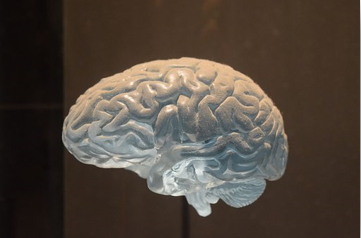
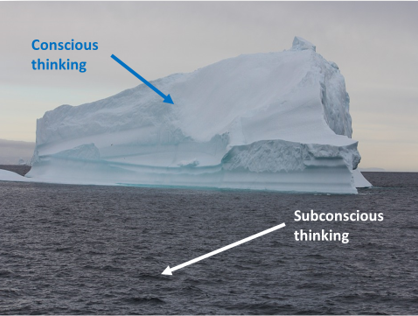
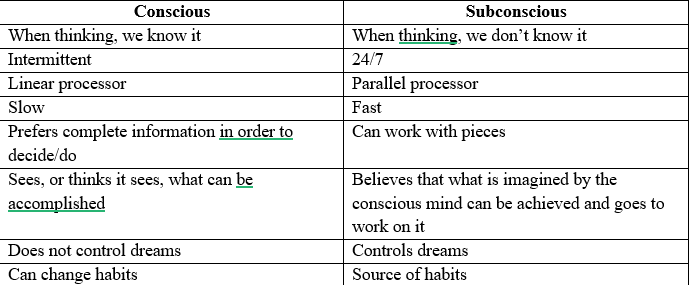
Read more: OUR CONSCIOUS AND SUBCONSCIOUS MINDS: A POWERFUL DUO -1
STEAM from the Gridiron
Kanoe Namahoe, October 25, 2017,Education ,Connected Teaching and Learning
Photo courtesy of 49ers STEAM Education
What happens when students experience science, technology, engineering, arts and math through lessons about football?
Practical learning, says Jesse Lovejoy, director of STEAM education and the San Francisco 49ers Museum. "Sports are generally understood and compelling," says Lovejoy. "They also happen to be a great lens through which to examine the subjects of STEAM or any other subject really."
Lovejoy coordinates the 49ers STEAM education program, launched in 2014 at Levi's Stadium. The initiative, part of the 49ers Foundation that serves K-8 students in Bay Area schools, aims to provide students with a real-world look at STEAM using the concepts of football.
I spoke with Lovejoy about what it takes to capture students' interest and open their eyes to the possibilities in STEAM fields. Here are some of his top tips:
Make it relatable. Sports make sense to students, even to those who are not athletes, says Lovejoy. "What we have in the game of football is this really simple and approachable idea," he says. "Sports -- whether kids like to play basketball, baseball, football or soccer, field hockey, swim or run -- they know what they are. They understand what it is."
More than half -- 56% -- of the students who attend the 49ers program come from Title 1 schools, according to reporting from Forbes. Many are young athletes for whom sports is their first language. Program activities -- such as math exercises around player stats -- help connect STEAM concepts to students' interests. The goal is to expose students to new opportunities that let them see how their passions connect to real life, says Lovejoy.
"Our mission [for] using this platform [is] as a way to change the way that kids perceive, relate to and want to explore these subjects," he says. "If we can reach these kids and be that moment of inspiration for them…[we want] to show them this is real life -- these are things you can approach through things that you love."
Speak about the job. It's time to redefine STEAM and help students understand it's not an "abstract concept that lives in a lab and wears a set of daisy glasses," says Lovejoy.
"Instead of speaking about the subject, speak about the job," he says. During their visit, students learn about different jobs at the stadium, including engineers, chefs, accountants, data analysts, football players and coaches, and how the work involved relates to STEAM. Lovejoy says the key is discussing these functions in practical terms students understand.
"When we're teaching engineering, I'll go in a classroom and tell a kid, 'Hand me something,'" he says. He explains how ordinary objects such as paper, pens or shoes are engineered and how that process helps continually improve those objects. Students also get to see how football helmets are built and how they have evolved over the years.
"And that whole idea is something kids are not usually presented with when it comes to the concept of engineering," Lovejoy says. "Making something better, making anything better."
Let them get their hands dirty. Hands-on activities are "very powerful for a child in terms of inspiring creativity and collaboration and critical thinking," says Lovejoy. He advises educators not to presume that students know what it means to be creative.
"You have to engage young people at a very primal and practical level to inspire creativity," says Lovejoy. "In some cases, you even have to tell them what it looks like and model it for them. I think they hear this word and think, 'Does this mean I draw something? What does this mean?' That's the first part."
The 49ers program uses technologies such as simulation and touch screens to deliver learning content but also places great emphasis on fostering creativity through project-based learning and tactile experiences. Activities such as creating face masks from straws and fitting them to helmets or using K'nex and wooden blocks to build a stadium help reinforce STEAM concepts, nudge students out of their comfort zones and let them develop creative muscles, says Lovejoy.
"For us, it's about putting things in the hands of young people, with the right information, and asking them to build something," says Lovejoy. "And intentionally doing that in a real-world environment and not in a digital environment. We want them to hold, touch and build. That, for us, has been very powerful."
Use process to teach job skills. Process is a valuable way to demonstrate practical application of STEAM concepts, says Lovejoy. Lessons about engineering begin by walking students through the steps of their day – from waking up to taking the bus to school -- so they can see how their activities connect.
"That is what's called a process," says Lovejoy. "Going through a process is what every single person does at their job every single day. Does that mean you're a scientist or mathematician? Not necessarily. But it means that you're employing the same principles that those people employ."
The exercise helps students identify the job skills needed for various STEAM-related careers. "When you start to think about the kinds of skills required to develop the capacity to become an electrician, to fix heating and ventilation and air conditioner equipment, these things are STEAM careers," says Lovejoy. "I think that's the start [of] getting out of this concept of STEAM as this really high-level concept for kids and breaking it down to relatable terms and occupations."
Fuel teacher enthusiasm for STEAM. The linchpin to a successful STEAM program is a committed, enthusiastic educator, says Lovejoy. To this end, the 49ers organization offers professional development to all teachers who participate in the STEAM education program. The half-day training sessions emphasize project-based learning and STEAM integration. All teachers return to their classrooms armed with lesson plans and access to additional resources. Lovejoy says 250 educators participated in the program last year.
"The most important part is the engagement, instruction, motivation and guidance of educators who care," says Lovejoy. "You cannot discount the importance of somebody in that room [who] will not let young people get away with giving mediocre effort -- [who] is not going to allow them to bail on the experience."
Kanoe Namahoe is the editor of SmartBrief on EdTech and SmartBrief on Workforce.